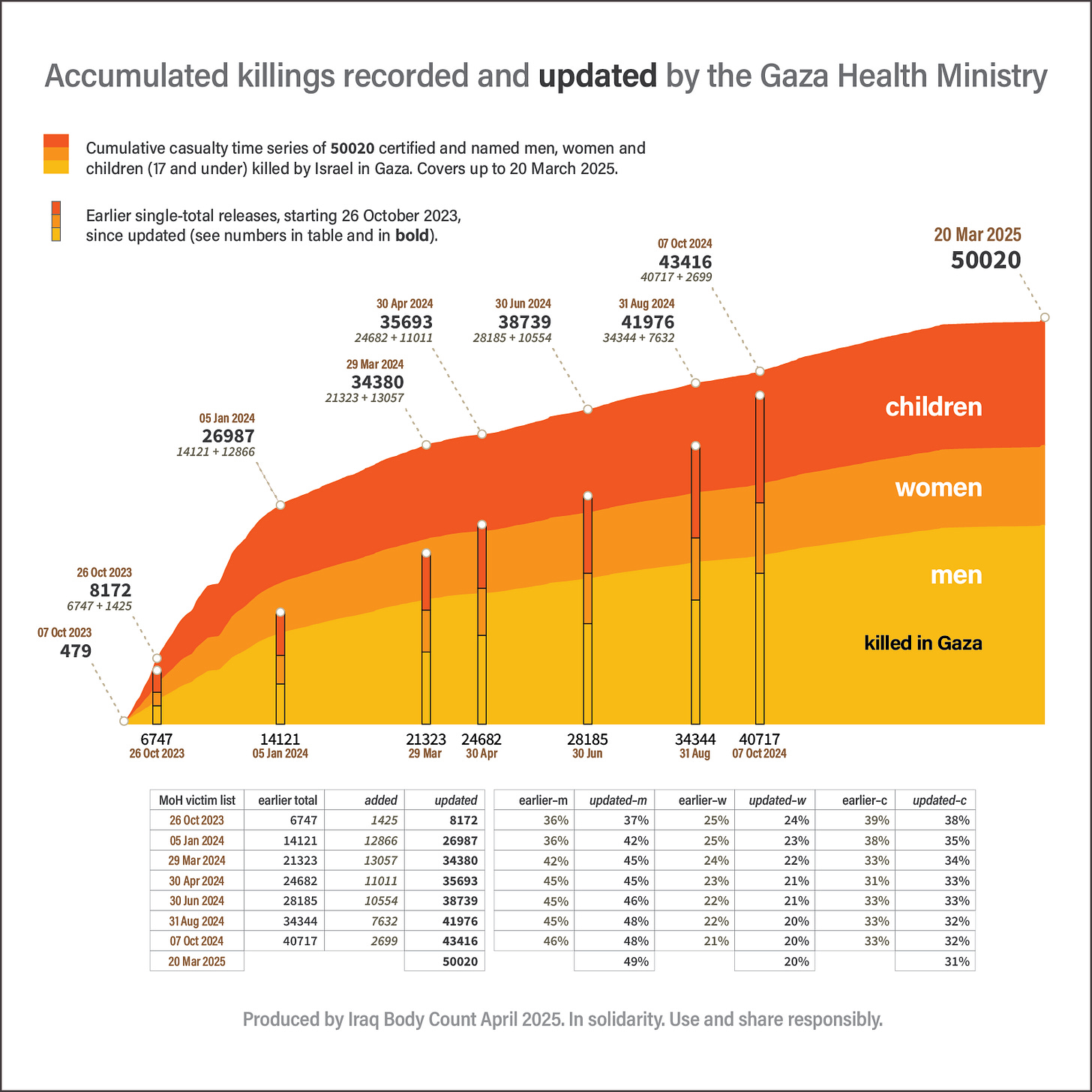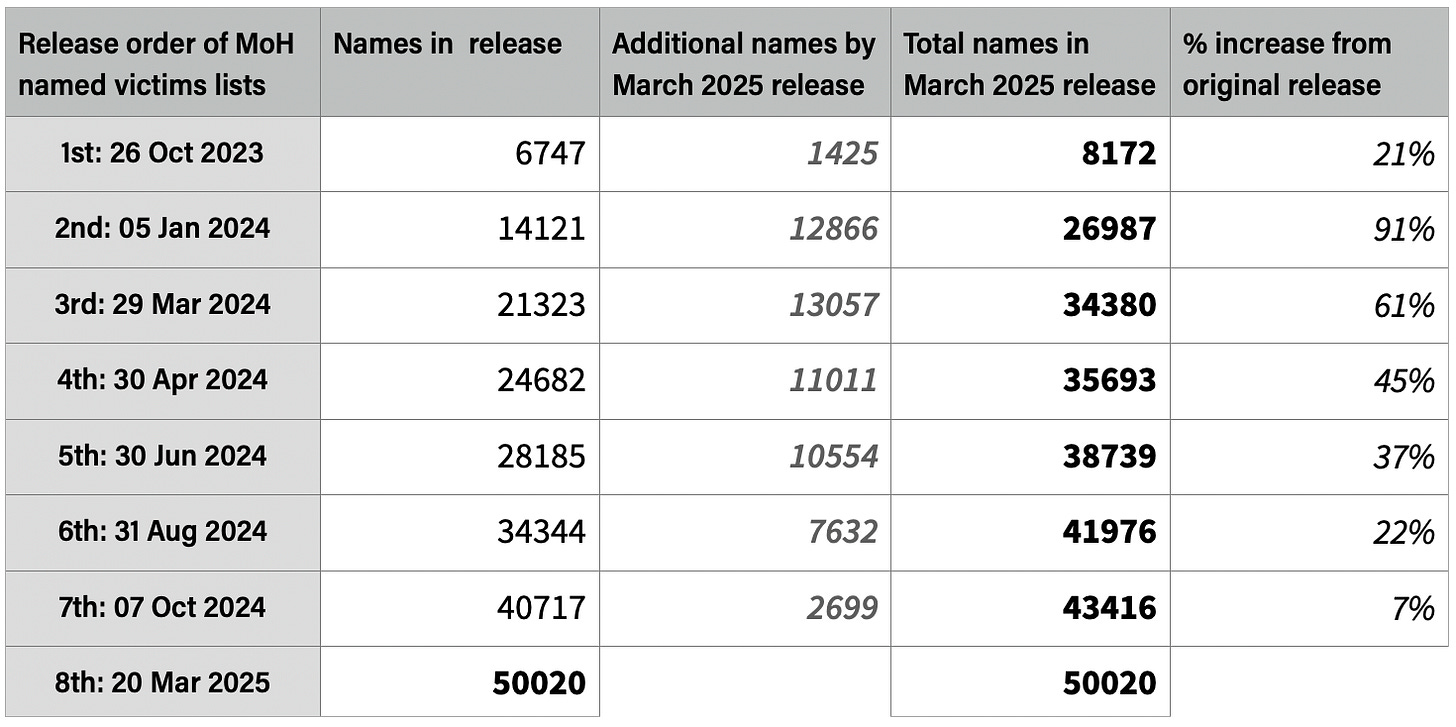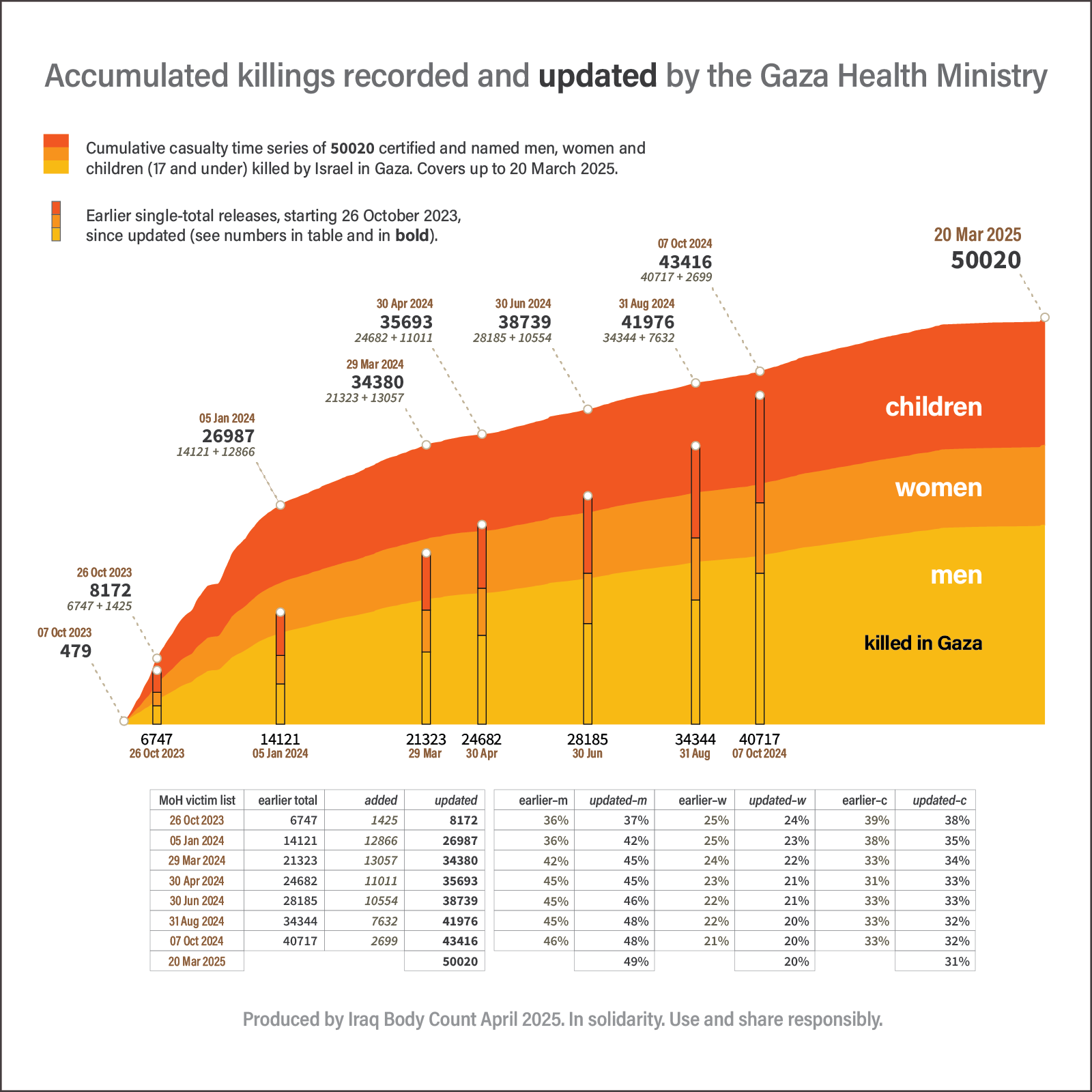In this first of a series of analytic articles we describe some remarkable findings revealed by an updated named victims list obtained directly from the Gaza Ministry of Health (MoH) in late March 2025 (with limitations placed on distribution, but not on analysis). This list contains greater detail than in any list made publicly available. We focus here on how the new detail in this list better allows us to document the progression and scale of the ongoing genocide.
A notable feature of Gaza’s official medical and medico-legal response to the Israeli attacks from October 7, 2023 onwards has been the periodic release of the names of its citizens killed and officially recorded up to that point in time, understanding that many would still be undiscovered or unrecorded. Gaza’s MoH has issued eight separate such lists, giving each victim’s name, age, sex, and ID number. Every list has been longer than the one before, in line with the escalating death toll.
What was unclear was whether the publicly–released lists recorded only the deaths that occurred in the period between each list, or contained some number of previously unreported or unconfirmed deaths for the earlier periods. We can now confirm that each list does contain deaths missing from previous lists, often increasing those earlier death tolls dramatically.
This can be established because the detailed list, provided to Iraq Body Count (IBC) on the strength of our track record in casualty documentation and analysis, contains an event date associated with each individual’s death. This means that we can now place each death into the period covered by a particular list, and see which were added only later.
A less detailed version of the list (which was the eighth and most recent) was publicly released in Arabic in PDF format on March 24, 2025, from which IBC produced a version with English–readable names, circulated on March 26. With permission we are today re-releasing that version as a single Excel file.
We show the key findings of our analysis in the following graph and table:

Columns in the graph represent the initial published lists and their cumulative total as recorded at the time of publication. The areas surrounding the columns show the full day by day timeline as recorded in the detailed list obtained by IBC. Different shades segmenting both the bars and the full timeline represent the numbers of men, women, and children killed day by day.
This reveals for the first time that:
- the eventually-confirmed number of individuals killed in each period is significantly higher than initially given;
- after the initial month, the largest proportional gaps were for the period when the death toll continued rising sharply (at 100 per day or more);
- it is this period which required, and received, the largest proportional updates;
- MoH efforts look to be narrowing the gap between potential and ultimately confirmed deaths.
The percentage increase of this constant updating effort by the MoH is shown in the table below. This shows for example that even the very first list—which recorded 6747 individuals killed up to October 26, 2023—has since been increased by another 1425 names, an increase of 21%, and that this pattern has held even more radically for most subsequent releases, reaching as high as 91% for the release of January 5, 2024 (an addition of 12866 names to its prior total of 14121).

For each of the earlier published lists some degree of supplementation can be observed in the subsequent list, demonstrating a continuous process of discovering and adding new victims.
There are of course further deaths still unreported, for reasons including the annihilation of entire extended families. Aside from this, in response to our questions, the MoH says that it is processing 4100 more deaths that occurred before March 2025, which if confirmed will raise the numbers for these earlier periods even higher.
And at the time of writing there has been another devastating resumption in Israel’s high-intensity killing (over 1600 deaths), most coming after the latest date of death in the names list of March 20. Those most recent deaths, too, are necessarily absent from it.
There have however been limitations to these lists other than missing entries, leading to some confusion about their content. We discuss some of these below.
The limitations of the older lists, and how the newer ones are better
The majority of killings were initially being recorded by hospitals, but because hospitals were also being attacked while the death toll was escalating, the quality of documentation in MoH releases visibly dropped. This was the very time when the documentation process needed to be at its most efficient.
The MoH was itself only too aware of its casualty recording limitations and consequently took pains to alert the public to this, most emphatically with its second list release of January 5, 2024:
Attached is a list of martyrs’ names registered through the Ministry of Health since the beginning of the aggression, noting the following:
- Missing persons and bodies trapped under rubble have not been counted
- Unidentified persons who arrived at hospitals have not been counted
- Unidentified persons whose bodies were handed over by the occupation have not been counted
- Those who were buried by their families without passing through hospitals have not been counted
- Casualties in Gaza and northern Gaza have not been counted since the information system stopped functioning in November.
The Ministry of Health calls on the families of missing persons and martyrs to review the attached list of martyrs registered with the Ministry of Health and to register the names of their martyred and missing relatives who have not been registered for the aforementioned reasons.
It is unsurprising therefore that of all the lists, the second is the most lacking by comparison to its current update, as is evident from its receiving the largest proportional increase among updates (91%).
Also noted with concern by close observers is the fact that this January 5 list, as well as the third (March 29) and fourth (April 30) were not nearly as clean as the first list released October 26, 2023. They showed a variety of internal errors and inconsistencies. These included: misspelled, incomplete or invalid names and ID numbers; missing values in the age and ID columns; duplicated as well as apparently missing entries (i.e., entries not carried forward from previous lists); and multiple names crammed into the space for one.
Another source of error was the apparent change in age at time of death for the same individual in different lists, likely due to embedded Excel formulas auto-updating the age.
Compounding these problems was that the lists were exported to PDF for public distribution, with all that this entails for Arabic language handling in software. This led to content corruption which degraded elements of the releases in unforeseen ways.
However from the fifth list (June 30, 2024) onwards, substantial improvements became visible. For instance, the age column in that list is completely populated, unlike the second, third, and fourth lists that preceded it. Most crucial for the findings we present here is that the March 2025 list has resolved the vast majority of the issues that previously hampered serious analysis.
Even in the best of circumstances and without the issues noted above, manual data entry across tens of thousands of records will involve errors. It is therefore commendable that the people working in Gaza’s MoH in the midst of intense bombardment managed to substantially address these problems in later releases, most notably the last.
Due to the earlier data corruptions referred to above, it has been difficult for us and others to establish, for instance, whether an individual appearing in one list and not in a later list was removed for sound reasons, or their details were merely edited to make corrections (thereby complicating re-identification), or were somehow lost altogether. But establishing the correct details for each person in such lists is surely important for the sake of truth, the public record, and a fuller understanding of human suffering and losses.
In contributing to these efforts IBC brings a perspective and understanding of casualty documentation, its methods and obstacles, gained through more than 20 years of practice and professional involvement. We see it as our duty to bring what we can of our insight and experience to bear on the genocide in Gaza.
Consequently IBC has been carefully disambiguating and recombining all of these lists’ contents in order to create a more unified and usable dataset. These efforts have enabled us to characterise in detail how the lists have changed and progressed.
In future articles we will use this knowledge to analyse and reveal other features of these lists. We will also critically appraise some high-profile accusations that have been publicly and (in our view) wrongly levelled at the work of MoH. Suffice it to say here that vastly more deaths have been added for every period than were ever removed from any list.
Exposing the genocide, person by person, name by name
Over and above any specific findings of particular analyses, it is important to recognise that these lists represent some of the most detailed and individualised accounting of casualties ever published in the midst of an intense military onslaught. Nothing comparable to these name lists was produced during the height of conflicts in Afghanistan and Iraq; and indeed nothing comparable has emerged since.
The efforts of Gaza MoH personnel—working under continuous attack—to regularly publish these lists represent a substantial advance in the practice of casualty recording. And what makes these data a powerful record of the documented human cost in Gaza is the evident continuous work to eliminate errors, add new victims, and deal progressively with the backlog of unprocessed cases, including the recovery and identification of remains from the rubble. This can only suggest that we are seeing dedicated professionals whose goal is accurate and complete recording of the horrendous losses being suffered by their people.
For all these reasons the MoH’s casualty recording achievements in Gaza deserve close attention from all those concerned with authoritative and lasting records of the casualties of armed violence. There can be no doubt that these records will be of critical importance to the accountability processes that surely must and will follow this genocide.
Source: https://iraqbodycount.substack.com
Disclaimer: We at Prepare for Change (PFC) bring you information that is not offered by the mainstream news, and therefore may seem controversial. The opinions, views, statements, and/or information we present are not necessarily promoted, endorsed, espoused, or agreed to by Prepare for Change, its leadership Council, members, those who work with PFC, or those who read its content. However, they are hopefully provocative. Please use discernment! Use logical thinking, your own intuition and your own connection with Source, Spirit and Natural Laws to help you determine what is true and what is not. By sharing information and seeding dialogue, it is our goal to raise consciousness and awareness of higher truths to free us from enslavement of the matrix in this material realm.
 EN
EN FR
FR


























